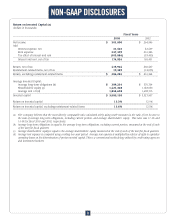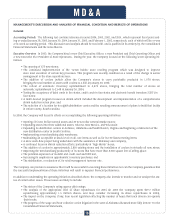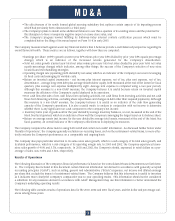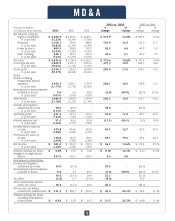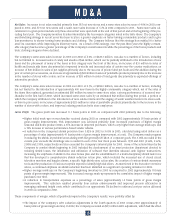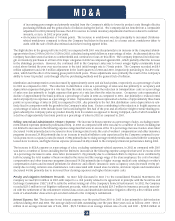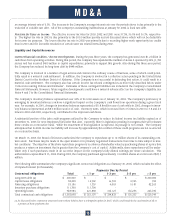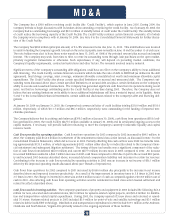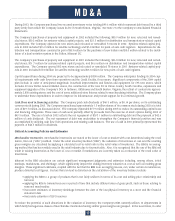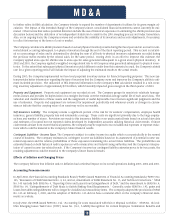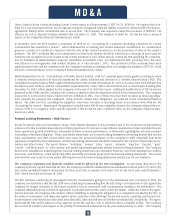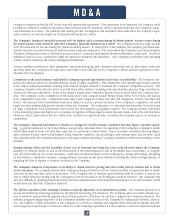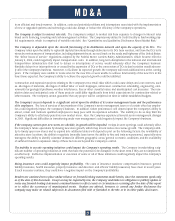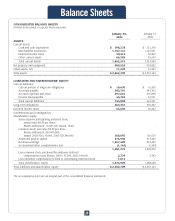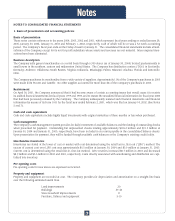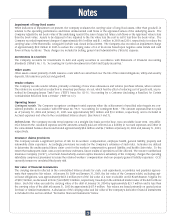Dollar General 2003 Annual Report Download - page 21
Download and view the complete annual report
Please find page 21 of the 2003 Dollar General annual report below. You can navigate through the pages in the report by either clicking on the pages listed below, or by using the keyword search tool below to find specific information within the annual report.
Other Costs to Exit an Activity (including Certain Costs Incurred in a Restructuring)" ("EITF 94-3"). SFAS No. 146 requires that a lia-
bility for a cost associated with an exit or disposal activity be recognized when the liability is incurred, whereas EITF 94-3 had rec-
ognized the liability at the commitment date to an exit plan. The Company was required to adopt the provisions of SFAS No. 146
effective for exit or disposal activities initiated after December 31, 2002. The adoption of SFAS No. 146 did not have a material
impact on the Company’s financial statements as a whole.
In November 2002, the EITF reached a consensus on EITF 02-16, "Accounting by a Customer (Including a Reseller) for Certain
Consideration Received from a Vendor", which addresses the accounting and income statement classification for consideration
given by a vendor to a retailer in connection with the sale of the vendor’s products or for the promotion of sales of the vendor’s
products. The EITF concluded that such consideration received from vendors should be reflected as a decrease in prices paid for
inventory and recognized in cost of sales as the related inventory is sold, unless specific criteria are met qualifying the considera-
tion for treatment as reimbursement of specific, identifiable incremental costs. As clarified by the EITF in January 2003, this issue
was effective for arrangements with vendors initiated on or after January 1, 2003. The provisions of this consensus have been
applied prospectively and are consistent with the Company’s existing accounting policy. Accordingly, the adoption of EITF 02-16 did
not have a material impact on the Company’s financial statements as a whole.
FASB Interpretation No. 46, "Consolidation of Variable Interest Entities" ("FIN 46"), expands upon current guidance relating to when
a company should include in its financial statements the assets, liabilities and activities of a Variable Interest Entity ("VIE"). The
consolidation requirements of FIN 46 applied immediately to VIEs created after January 31, 2003. In October 2003, the FASB deferred
the effective date of FIN 46, and the consolidation requirements for "older" VIEs to the first fiscal year or interim period ending after
December 15, 2003, which applied for the Company at the end of its 2003 fiscal year. Additional modifications of FIN 46 may be
proposed by the FASB, and the Company will continue to monitor future developments related to this interpretation. The Company
leases four of its DCs from lessors, which meet the definition of VIEs. Two of these DCs have been recorded as financing obliga-
tions whereby the property and equipment, along with the related lease obligations, are reflected in the consolidated balance
sheets. The other two DCs, excluding the equipment, have been recorded as operating leases in accordance with SFAS No. 98,
"Accounting for Leases." Based upon the guidance included when FIN 46 was originally released, the Company adopted the pro-
visions of FIN 46 on August 2, 2003, and the adoption of FIN 46 did not have a material effect on the Company’s financial state-
ments as a whole.
Forward Looking Statements / Risk Factors
Except for specific historical information, many of the matters discussed in this document and in the documents incorporated by
reference into this document may express or imply projections of revenues or expenditures, statements of plans and objectives for
future operations, growth or initiatives, statements of future economic performance, or statements regarding the outcome or impact
of pending or threatened litigation. These, and similar statements, are forward-looking statements concerning matters that involve
risks, uncertainties and other factors which may cause the actual performance of the Company to differ materially from those
expressed or implied by these statements. All forward-looking information should be evaluated in the context of these risks, uncer-
tainties and other factors. The words "believe," "anticipate," "project," "plan," "expect," "estimate," "objective," "forecast," "goal,"
"intend," "will likely result," or "will continue" and similar expressions generally identify forward-looking statements. The Company
believes the assumptions underlying these forward-looking statements are reasonable; however, any of the assumptions could be
inaccurate, and therefore, actual results may differ materially from those projected in the forward-looking statements. The factors
and risks that may result in actual results differing from such forward-looking information include, but are not limited to:
The Company’s reputation and financial condition could be affected by the SEC investigation. As previously disclosed in the
Company’s periodic reports filed with the SEC, the Company restated its audited financial statements for fiscal years 1999 and 1998,
and certain unaudited financial information for fiscal year 2000, by means of its Form 10-K for the fiscal year ended February 2,
2001, which was filed on January 14, 2002.
The SEC has been conducting an investigation into the circumstances giving rise to the restatement and, on January 8, 2004, the
Company received notice that the SEC staff was considering recommending that the SEC bring a civil injunctive action against the
Company for alleged violations of the federal securities laws in connection with circumstances relating to the restatement. The
Company subsequently has reached an agreement in principle with the SEC staff to settle the matter. Under the terms of the agree-
ment in principle, the Company will consent, without admitting or denying the allegations in a complaint to be filed by the SEC, to
the entry of a permanent civil injunction against future violations of the antifraud, books and records, reporting and internal con-
trol provisions of the federal securities laws and related SEC rules and will pay a $10 million nondeductible civil penalty. The agree-
ment with the SEC staff is subject to final approval by the SEC and the court in which the SEC’s complaint is filed. The Company
has accrued $10 million with respect to the penalty in its financial statements for the year ended January 30, 2004. The Company
M D & A
19


